Morocco
Deserts, Dunes and Gorges
A
photo-safari to the Moroccan
Atlas region was completed
on November 25th 2001. This
trip explored Berber trails, camel pistes and mule tracks
between the Great Western Erg (Sand Sea) of Algeria and the
Atlas Mountains of Morocco. The
vehicle was a modified Land Rover Discovery desert camper
which perfomed faultlessly.
A Land Rover Voyage To The
Moroccan Sahara
By Kit Constable Maxwell
Monday November 5th
I left the Loire Valley, France, and reached the Spanish border
that night. I camped at a pull-in on the auto-route. Drove
all day Tuesday and most of the evening to Almeria,
Spain and took the 9pm boat to Nador, Morocco. The
boat was full of Moroccans and I was the only European on
board. I slept all night at the café table in 'head-in-soup'
mode. Breakfast 05.30am, disembarked at 07.30am. I drove south
towards the Algerian border. After only 2½ days on the road
I was driving through a boundless expanse of north Saharan
desert.
I stopped for lunch in the desert - just bread and jam, but
what bread, delicious Moroccan flat-bap bread, and what jam,
home grown Moroccan date jam, and what a site - virgin desert,
sun, sand and wonderful silence. The whole organisation for
this trip and months of pre-planning now became worthwhile
at this one time!
I arrived at Tendrara with a sandstorm blowing up and
spectacular desert rainstorm starting. (This was the time
that Algeria suffered a cataclysmic storm that killed 800
people). After two police checks (Name: 'Constable',
nationality: 'Britsch',) and I arrived at the small
provincial town of Bouarfa. Here I bought onions, potatoes,
carrots and green peppers in the vegetable market and pulled
off to the outskirts and made camp. I was attended by many
wild dogs defending their territory, with vociferous challenges
to visitors, including me!
Thursday November 8th Drove
East towards border town of Figuig but turned off just
before to Al Mengoub. This piste is shown as 'prohibited'
on the Michelin map, but there were no signs locally so I
continued. This piste was demanding, exciting, challenging
and picturesque. It wound it's way across a broad plain bordered
by two steep jebels (mountains) which dictated the general
direction.
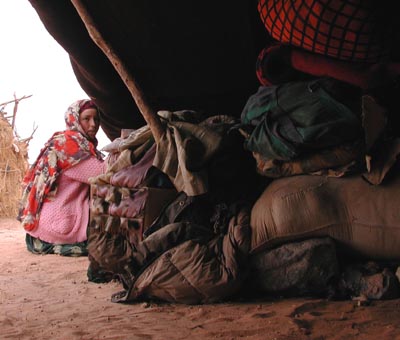
Nomad
girl in her Berber tent, Moroccan Sahara
|
I gave a Berber nomad a lift for the first 10 miles to an
encampment of low black Berber tents. The piste got worse
after this with many flash floods destroying all evidence
of previous use - demanding long detours to continue. I used
my compass and GPS regularly to maintain heading and position.
Flash floods cut deep ravines across the plain and at several
I bottomed out on the towbar drop-plate that I had failed
to modify before leaving.
I came to a small fort at Ain Tanzara, the only mapped
feature on the route. There were amazing rock formations here
and precipitously steep valley walls.
The trail was very remote now with no signs of life or vegetation
for mile after lurching mile. I came to a very difficult wadi
crossing which required a long detour to get to a point where
the steep sides were negotiable by Land Rover. After a perilously
steep descent I had to drive down the wadi a little way to
find an exit. With lots of scrambling and wheel-spin I emerged
on the other side where I was able to continue with my intended
heading.
Eventually the valley opened out and some vegetation appeared.
I came to a small flock of goats tended by a shepherd boy.
A little further I came to a crude mud hut and a wonderful
nomadic family who welcomed my intrusion with great interest
- I believe they had seldom seen a car before, and not for
a very long time on this abandoned route. The family consisted
of a young father and five children plus his wife and mother-in-law.
All were very friendly and pleased, albeit coyly, to be photographed.
Later I came to big sand dunes drifting across the piste and
clearly there had been no one down this way for months. Eventually
I arrived at Al Mangoub on the old border railway,
long abandoned now and near derelict, with rails lying buckled
in the heat. No cars here. I crossed over and arrived at the
Boudnib road. The end of my track was closed off with
a large concrete barrier and a sign - No Vehicle Permitted!
I drove around it with a slight smirk, and continued to Boudnib.
This proved to be a shabby, crowded town and I continued a
few miles before turning off into the desert. I drove East
for a mile or two and came to a slight land depression which
I recognised as a wadi flood lake, perfect for camping, level
and out of sight. It was dry and very warm in the setting
sun. I had a bath in the washing up bowl and changed for dinner.
I cooked up a chicken-and-vegetable dinner served with local
bread and fresh oranges. Coffee with the rising moon, the
distant call of wild dogs, and such silence. Retired to bed.
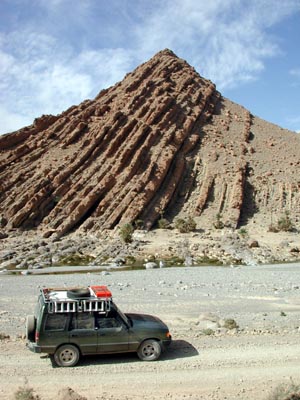
...amazing
rock formations and steep valley walls
|
Friday November 9th Left at mid-morning
and drove back onto the Er-Rachidia road. In a few
miles I turned up an unmarked track to Al Goreme. This
was a steep ravine with date palms waving on the wadi far
below, and precipitous rocks towering way up above. The route
was stony and rough, very desolate in parts; it took 5 hours
to reach the other end which came out near the Gorge Ziz
and a good road south.
I stopped at a very nice campsite called 'La Source Bleue',
which owed it's name to an underground river emerging from
a cave in a remarkable blue colour -caused, no doubt, by some
subterranean mineral, probably copper. Even the fish in the
pool were blue! The water ran out into a wadi which supported
a forest of date palms; I parked the Land Rover here, made
friends with the locals and camped for the night.
I met another desert traveller here, Fritz, and photographed
his detailed piste map on my digital camera, from where I
would import it onto the laptop computer and plot my route.
"Digital camera? Laptop computer? And all this in Africa?"
Said the bemused Fritz…
When I had finished a Frenchman came up and said:
"Oh I have a spare one of those piste maps" and gave it to
me.
Ah well…how friendships flourish in such places!
I then drove on to Erfoud and bought a nice wooden
Berber thing for £6, negotiated down from £22. I then missed
the all important turn for Merzouga. Some eager local
lad pointed me down a bustling street market to a wadi crossing
that had collapsed in the last storm. I had a ghastly time
extricating myself, with people and products in close contact
with the Land Rover on all four sides. Crawling speed was
much too fast, and one trader after another had to move piles
of vegetables, spices, pots, pans and marketplace merchandise
to let me through. A small boy worked wonders for me moving
people aside. I was very relieved to get out of that intensely
Arabic gathering where tourists and their cars were not welcome.
Extricated at last, I drove out on a good track towards the
picturesque dunes of Erg Chebbi. I stopped at an old
fort half way down and took photographs of dunes and camels.
I arrived at Merzouga's southern gateway and set off
for the more difficult section to Taous. I arrived
at the expected chott (dried up flood plain) and then lost
the piste almost immediately. I drove into ever more hostile
territory with holes, steep banks, deep cuts and soft sand.
After a long way searching for the piste on the left of my
heading (it was on the right), I decided to backtrack to Merzouga
and start again. All very exhausting.
On the way I encountered a shepherd boy with a punctured bicycle.
I put him and his bike on board and he directed me, not to
the Taous piste that I was looking for but to another
piste leading (eventually) to his own house. His sister appeared
and tea followed, which was very welcome by then and I had
a nice time chatting. Off again, the boy directed me to a
different piste leading off into the hills and assured me
it would take me to Taous. Well, it did, eventually,
but the Taous villagers expressed some surprise as
no vehicles ever used this abandoned trail. The difficult
bit was a large wadi crossing near the end, with flood silt
and other obstructions revealing themselves in the now failing
light. I stopped to savour a wonderful sunset over the wadi
between the hills.
I drove through the village and camped in a small valley two
miles beyond. Alas, not far enough, I was joined quickly by
one, then two, then three eager hustlers all trying to sell
me fossils, camel rides, guided tours etc. Moroccans can be
very persistent. I resisted their advances and eventually
I was left alone in the starlight for a quiet and welcome
night. It had been a long and difficult drive and I was happy
to draw the curtains and snuggle down into the sleeping bag
on the converted bunk in the rear of the Land Rover.
Next morning I awoke early and… there was yet another boy,
Mohamed, sitting patiently in the morning sun waiting to sell
me something. My first reaction (after a few uncharitable
thoughts) was to go back to sleep again! I got up, eventually,
and spoke to him about the route to Zagora. He informed
me that the dried river crossing, Wadi Ziz, was 5 miles
wide (8km) at this point and it had flooded recently, and
the piste had been washed away. And did I want a guide…?
I was a bit worried that up-country storms (of the sort that
hit Algeria so badly 4 days before) might flood the wadis
and make them impassable. This wouldn't have been the first
time this had happened to me in southern Morocco.
We negotiated a deal and I became the owner of some of his
best Neolithic arrowheads at the same time. I hired him for
the duration of the trip, about four days, and would drop
him off at Zagora from where he would have to make
his own way home. The fee agreed was £60. I took him back
to Taous where he checked out with his young wife and
son, packed a blanket to sleep under, and off we went.
The piste meandered off through the sand and then disappeared
altogether. We struggled on through soft sand, ruts, baked
chott, (dried flood lakes) and hamada (rock strewn plains).
I was very glad to have Mohamed travelling with me, I would
not have wanted to do this section alone without a local guide.
At his suggestion we diverted several miles across a flat,
featureless, floodwater plain, and just as we appeared to
be heading nowhere we came suddenly to a shallow land depression
below the mountain range with a Berber settlement just below.
There were only two or three families living here, each in
their low, black, camel-hair tents, a brace of ass, some scrawny
chickens and the all- important well.
Here I was invited in to the main tent, a straw and reed-bound
structure laid inside with carpets and rugs made by the family.
I shed my shoes in respect for local custom and sat cross-legged
on the rich Berber floor covering. The older woman was working
a Neolithic grinding wheel and grinding oat seed. Drawing
her veil respectfully across her face, she fed small handfuls
of grain through the opening at the top. The grain would drop
down between the two flattened stones and spill out as a coarse
flour onto the prepared collection cloth, all ready for baking.
Round and round went the grinding stone in a steady rhythm,
with mother chatting away to the others in a scene little
changed since biblical times.
The two teenage girls were busily engaged on the loom. They
were working in unison, threading, tying, knotting, tamping
and dressing the emerging carpet. A Berber carpet may have
100,000 knots in it and each knot is looped by zealous hands
practicing time-proved skills. None of these carpets were
for sale, they would provide for the family's needs…
In the next tent another girl, Mahomed's nomad cousin, prepared
tea and dates. I moved across to this larger tent and sat
beneath the thick black camel hair covering, admiring the
ornate carved and decorated centre plate which supported the
centre. Several children remained politely outside, staring
in silent fascination at this new visitor in their midst.
I was sorry to leave this little settlement with those wonderful
people, where every day made new demands and everyone contributed
to the common cause. There was a spirit of generosity and
friendship here, so typical of desert people. I took many
photographs before finally bidding goodbye and continuing
our journey to Zagora. We returned across the plain
and rejoined a progressively worsening piste.
Suddenly the Discovery was stuck, bellied down in a deep soft
sand dune with all four wheels churning helplessly. I carried
sand ladders and had but hoped not to use them; they are hard
work in the midday heat. I was able to shunt and wriggle and
got enough purchase to reverse back down the slope. I tried
again at a slightly different angle, and faster. I shot over
the top and found myself skidding crazily down the other side.
Mohamed gripped the dashboard and turned white...
Hazardous but successful, and I was back en-route.
Mohamed asked for some music on the cassette player, expecting
the latest European pop hit. I selected a passing favourite,
Mozart's Requiem.
"Is it in the hit parade?" he enquired eagerly
"Its 200 years old" I said.
"200 years…?" his tone was disbelieving.
"And written for dead people…"
"Dead people................?" He looked aghast,
and the look on his face spoke volumes…
After a few minutes he said… "Please turn it off",
with much laughter.
We picked up a youth near Tafaroute who rode on top
on the roof rack, and took him to his three-hut village. He
cooked us a splendid omelette on a portable desert oven called
a tazin. We continued late into the afternoon, sometimes
on soft sand and sometimes on black hamada. It's a very long
way, I thought, and I wouldn't want to come this way alone.
We didn't meet a single car for over 100 miles. The piste
was deeply covered with blown sand which had lain undisturbed
for weeks.
We stopped at dusk at a lone desert hut behind a mud wall.
A family was living within and immediately made us welcome.
Tea was prepared and it was agreed Mohamed could sleep in
the shelter. The family consisted of a crop-growing Berber
husband, his wife and 6 children, aged 10 years old downwards.
As I write this log I have three small beady eyed children
sitting in the back of the Land Rover with me - watching every
move intently. They smile but they don't talk, they just observe.
I ask them their names; Ales, Elysa and Liiya. I draw 3 wide-eyed
portraits, one for each, and they all laugh…
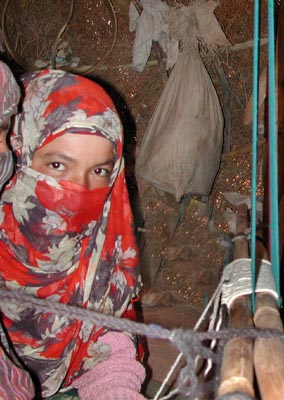
Nomad
girl weaving
|
Dinner was announced. Mohamed and I sat with the farmer and
his eldest son (8 years old) and we shared a low table, 4
spoons and one bowl of couscous and vegetable. The remainder
of the family shared the another bowl.
Next day we drove on through picturesque mountain valleys
interspersed with sometimes challenging sections of sand and
rocks. We stopped at a desert well where the water was clear
and cool. Eventually we came to signs of habitation, a few
nomads grazing camels, then date palms and further on, sparse
crops of root vegetables encircled with mud walls to keep
the camels out. At last we joined the main road and reach
Zagora, called the 'gateway to the Desert', and a charming
camp among the palms. I was the only guest there.
Mohamed left to arrange some way of returning to Taous,
and came back half a day later to say he had organised a lift
half way and would worry about the rest of the journey when
he got there. We shook hands and he left - whereupon he promptly
returned and gave me, quite unexpectedly, a Moroccan hug and
kiss. Charming…
Zagora 13th November 2001 I had
a good day in camp doing maintenance, refitting and repacking.
I wrote postcards and basked in the hot sunshine. I was greeted
by Hassan who signed me in according the efficient Moroccan
procedure, and then offered me his services as a guide. After
some detailed interrogation to establish his credentials,
I hired him. In the afternoon we drove up to Sugar Loaf Mountain
on the outskirts of Zagora, then out to some dunes
and a Berber hospitality tent to watch the sunset.
Later I bought an antique stone grinding wheel for Argan
oil and a Touareg drilling tool from Hassan's uncle at his
wonderful shop on the wadi. I negotiated a tough deal for
both and reduced the asking price by 500%! Argan was brought
to Morocco by the African Drua tribe from further south,
who began to travel up-country looking for work around 1750.
They gave their name to Morocco's biggest river wadi which
became known as the Drâa Valley. These agricultural
workers were known as the Haratin. Argan replaced
the indigenous olive as a source of oil, and the grinding
wheel has a carved collecting tray with a pouring lip. The
whole piece represents wonderful craftsmanship and the work
of countless months of carving and chipping at a hard desert
rock, using only another rock and a carving tool.
The drilling tool is a central stick with a cross piece, with
a circular stone balance-weight to give it momentum and drive.
The cross piece is moved up and down the central stick and
the camel leather traces wrap and re-wrap around it to create
rotation. Typically Toureg, it is inventive, effective and
ingenious.
Next day Hassan appeared on time and we left for Tagounite.
We drove off into the dunes and through a fertile palmerie.
Then we bought food and fuel in town. We turned off into the
desert just before M'hamid and arrived at a Berber
hospitality tent and a great welcome from Hassan's friend,
Saïd, who lived there. Saïd was very friendly and I was given
free use of the Berber tent. We sat on a hand woven carpet
and drank mint tea in tiny glasses, following long established
desert traditions.
Then the camel boy, Salim, was summoned. Salim was one of
10 children born to a desert nomad family, and was now about
20 and charming. He spoke of his upbringing in the desert.
"We wanted for nothing", he said, "and had many things to
do and much fun to be had". For the older ones, now, he conceded
that the town life held many attractions, not least, education.
He had never been to school and couldn't read or write. However
he had learned French from passing travellers and we could
converse very adequately together.
Saïd dressed me up in his flowing Touareg robe and a white
turban and I was ushered outside where the camel, a big bull
called Moushi, was 'couched' and waiting. By now I looked
like Lawrence of Arabia. I mounted the camel, which rose to
his full and considerable height. From aloft I could see the
sand sea stretching away east to Algeria. Salim took the camel
rope and set off barefoot across the hot sand, leading Moushi
and singing cameleers chants. Camels have an uneasy rolling
gait and you sit far back, staring at that great shaggy head
and the sand beyond. It was a rare and not unpleasant experience,
but I was glad I wasn't embarking on the 52 days camel trek
to Timbuktu, the traditional destiny for Berber and Touareg
camel traders in this part.
The ride over, Hassan produced me a wonderful salad lunch
of chopped onion, tomatoes, green peppers, chilli, all topped
with Moroccan sardines and Berber flat bread, baked that morning
in Tagounite. I sat back in my black camel-hair tent,
looking out over the sands while basking in this rich desert
experience. I reflected how different this was from my life
in a western urbanised environment …Could I swap places with
Salim? Probably not, but I was briefly tempted!
A short siesta later Hassan reappeared and we remounted the
trusty Land Rover and set off across the sand, bidding farewell
to the hospitable Saïd and his camelier Salim and the wondering
Moushi. In the Land Rover we followed varied and sometimes
tricky terrain. We drove between dunes, over dunes and across
dunes in an assortment of routes and headings that would have
lost a navigator in minutes. I had GPS which showed me the
straight-line route to any given point, but surprisingly there
are few straight lines in the desert. We crossed a large area
strewn with big sharp basalt rocks the size of footballs.
The Land Rover was unstoppable and tackled this lunar terrain
stoically. This was probably the first time in a million years
that anyone had passed this way, on wheel, hoof or foot. It
was too rocky for camels, too dry for goats, and it led nowhere.
Why were we on it? Because Hassan was lost, though he didn't
admit it… and we were cross-tracking to pick up the piste
across the wadi.
We stopped at a well and met two Belgians, Axel and Anne,
and their old sheepdog. They were experienced desert travellers
and were travelling to Chinguetti, Mauritania, where I had
travelled recently. We exchanged news and drove on.
We left the main, if intermittent, piste and struck off East
across a dried flood lake. Suddenly we were among greenery
with many grazing camels. We stopped to talk to a herder and
his young children. We continued through this small lush area
and out into a picture-book desert of sweeping dunes, mirages
and silence. Across one dune and over another, we came to
a small Nomad's tent in the middle of nowhere.
It was a friend of Hassan - Moroccans have friends everywhere
- and we were invited in for tea. We sat cross legged in the
sand and swapped the day's news. The friend helped us select
a picturesque dune with a sweeping curve and a sharp crest.
Here we camped for the night. A wonderful sunset threw lengthening
shadows on the dunes and the outlook changed every time we
looked up.
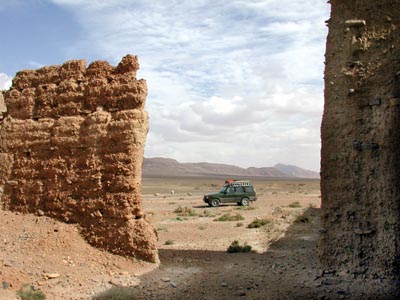
...abandoned
desert fort
|
Hassan cooked a chicken in a small clay tazin, a desert
oven we had brought with us. Charcoal was laid on the sand
and lit with a little dried grass and a single match. The
meal consisted of two chicken quarters set on a bed of carrots,
onions, potatoes and green peppers; all were cooked at once
with a little cooking oil, thinned with water and seasoned
with salt, cumin and pepper. The sun had set now and the first
stars appeared in the crimson afterglow as darkness fell.
All was still and quiet. We sat around the fire and ate with
our fingers. The silence was amazing. Desert memories are
made of this, I thought, and this is as good as it gets!
After dinner we chatted in French, and Hassan told me he lives
in the Palmerie near Zagora.
"And I have two camels…"
"And where do they live"? I asked
"Oh, in my house…"
We drank sweet mint tea under a canopy of stars so bright
you could almost read, so plentiful you got dizzy counting
them and so varied you became star-struck, watching for the
next shooting star, 'un étoile filante', to pierce
the night sky. The sudden shaft of light would streak across
the starry canopy and cast a luminance about it that lingered
on for precious seconds before it died into the night. Hassan
went off, with his blanket, to settle himself down for the
night on a sand dune, while I repaired to the comforts of
my desert-prepared Land Rover.
I awoke to the splendour of a desert dawn with a golden rim
of light haloing the highest dunes. I got up in my pyjamas,
and barefoot, to take photographs - it was very cold, but
so beautiful. I made coffee and returned to my warm bunk.
After a breakfast of Berber bread and date jam we left for
a long and splendid drive from the dunes back to the piste,
which we followed briefly. Hassan then turned off and we went
to a well, where we stopped to speak to a grand old nomad
lady. I gave her a carrot and she was delighted, striding
off into the desert with it clutched under her djellaba. A
young mother turned up with two small children. She got a
carrot too and the children got a bon-bon each. I was now
running out of carrots and bon-bons!
Later we picked up two elderly nomads striding across a great
plain with no obvious goal. One was the father of the young
mother. We took them a few miles and they pointed to a small
wadi where they had a friend who could sell them flour. Off
they went without complaint for the demands of their desert
life.
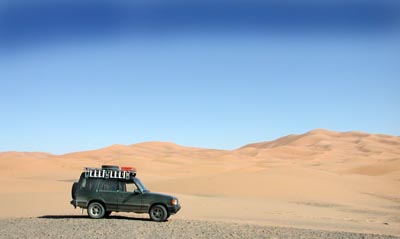
...surrounded
by boundless space and limitless sand
|
A little further and we reached Lac Iriqui. There had
been no rain in this part for some years and the lake floor
was dry. It was about 60 miles across, flat, level and interspersed
here and there with soft sand, dry rivulets and the occasional
rock. On the best bits I could do 60 mph.
Across the lake we reached the main piste which was in good
order and we cruised into the little market town of Foum
Zguid at around 2pm. We bought supplies and drove on to
a small oasis where Hassan made another of his great sardine
salad lunches.
Several locals dropped by to say hello - no hassle here, no
pushy street vendors offering their wares - and it was good
to have an interpreter to help converse and respond to their
genuine desert hospitality.
We drove on up a track, past a silver-mine in the foothills
of the Anti Atlas then off into a wild mountain upland on
an appalling trail. We followed a big wide valley with mountain
and cliffs on both sides looking like a Tibetan grazing plain.
There were some stunted trees here, but no grass, no animals
and no people.
We had to cross a very steep wadi - Hassan looked nervous
but the Land Rover didn't falter. We joined a better piste
quite near to Agdz and passed some beautiful unspoilt kasbahs
in the setting sun. We got to Agdz at dusk and drove
on up the hazardous mountain road to Ouarzazate.
I dropped off Hassan, went to the campsite and cooked up a
sumptuous meal. It was now late but very cosy in the Land
Rover with curtains drawn, candles lit, dinner with dates
and nuts for desert, and music by Berlioz.
I stayed at Ouarzazate for another day then left to drive
up the spectacular Dadès Gorge. I made frequent stops
to photograph the ever changing gorge scenery. Got to the
top at last and eventually found the turn off for Al Hani.
It wasn't marked, but there was a small arrow painted on a
rock and someone had written next to it, in English, the word
"Tough".
This looked promising, I thought. I was high up the Atlas
Mountains and still climbing, and I didn't expect this mountain
trail to be either graded or maintained. I scrambled up a
spectacular valley on a very tough track with everything rattling
and shaking; any lesser car would have failed in that first
5 miles.
It was getting late and the sun had gone down so I didn't
take many photographs. I didn't want to camp in this high,
remote mountain pass so I urged the Discovery on above the
tree line, with snow lying in sheltered pockets, and pulled
up in a small clearing at dusk an hour later.
It was very cold, very quiet and one of the loneliest places
I have ever been - or camped in. I lined up North/South so
as to catch the rising sun at dawn. After dinner I watched
the shooting stars against the stark contours of the rock
cliff and bluffs above. Bandit country, I thought, and locked
the doors as a precaution. This was wolf country too, but
there was little I could do about that…
The night was cold, still and silent. I awoke at 4am and made
some coffee. Another sleep and I woke with a bright rim of
dawn outlining the surrounding mountains. I packed up and
got under way with the heater full-on and breakfast postponed
until it got warmer. The track meandered on, up and through
some of the most spectacular mountain scenery. I stopped many
times to photograph the ever changing vista. Scattered snow
lay everywhere, stunted shrubs cropped up here and there,
otherwise it was just a desolate expanse of rocks, crags,
cliffs and boulders.
I went through another gorge before climbing steeply to 8,680
feet. Here I had a splendid view of the snow capped Mt
Tademant, 10,521ft, a little way above my elevated position
in the High Atlas mountains. An eagle soared high into the
clear blue sky, while two ravens foraged lower down the slope.
I stopped regularly to photograph the changing vista.
At another steep sided gorge I heard the melodious sound of
a shepherd girl calling her small flock. This was the first
indication I had that I was not completely alone in this spectacular
landscape. The flock was far above me on the top of a perpendicular
rock face bordering the gorge. I watched sheep and shepherdess
move along the crest, sometimes silhouetted against the sky
and sometimes out of site over the other side. The peace,
beauty and stillness of that charged landscape pulsated slowly
under a warm sun and a cloudless sky.
I drove on… Around the next cliff a young nomad girl came
scampering down the steep slope. Clearly I was now under surveillance,
and little brown faces would soon appear, to smile and wave
in the hopes of receiving a bonbon or stylo in return.
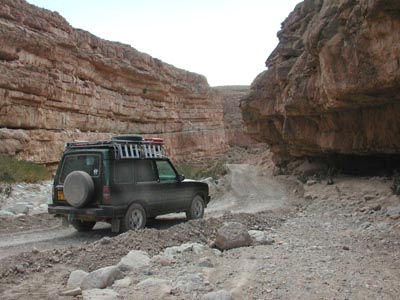
...steep
gorges in the mountains
|
This girl, Alyssa, was about 6 with piercing brown eyes and
a wide shy grin. I gestured with my camera and she responded
with an engaging repertoire of smiles. I took several pictures,
and rewarded her with a polo mint and a tangerine. She was
delighted.
The track wound it's way down valleys, up over headlands,
across steep wadis and through more spectacular gorges. At
last it ascended steeply up the terraced side of a rough and
precipitous canyon. I drove up at walking pace in low ratio,
first gear, and even that was a bit fast for some of the rocks,
crevasses and gashes that scarred this abandoned mountain
trail.
On top at last and the landscape opened up - lying far below
was the valley floor and in the distance, the hamlet Al
Hani. Here I would join the graded road that goes right
down through the Todra gorge and on to Tinherir
and the Er Rachidia road.
I drove down with some regret for leaving one of the most
spectacular, demanding roughest cross country drives I have
done. Todra is a splendid gorge too and is not to be
missed, but is well exploited and over populated. It lacks
the excitement, challenge and satisfaction of that High Atlas
crossing.
I then drove to Er Rachidia and that amazing oasis
at Le Source Bleue. I bought an antique Touareg couscous
bowl, inlaid with camel bone and silver symbols of moon, sun
and stars.
I continued northwards for a few days and then completed a
long tortuous drive through the Rif mountains, right
down to the Mediterranean at El Jebha. I was offered
hashish everywhere - this is a prime growing area - and made
it the port at Ceuta for the evening ferry to Spain.
All vehicles where searched here for drugs with eager, tail-wagging
sniffer dogs. I took the new hydrofoil and in 35 minutes I
was in Algeciras, Spain. A long drive through Spain
- I did over 600 miles next day - and I arrived back in France
at the end of November, with the speedometer showing an exhilarating
extra 3,460 miles!
This was a wonderful trip, full of fun, culture and interest.
Morocco has a lot to offer, and I was able to experience and
enjoy some of the best of it.
© Kit
Constable Maxwell